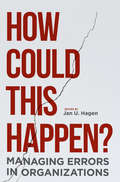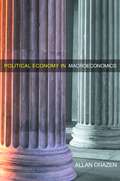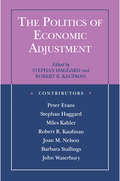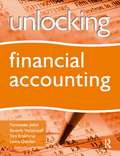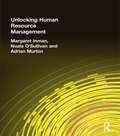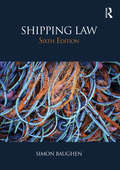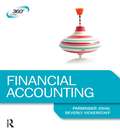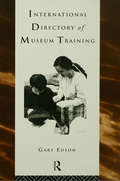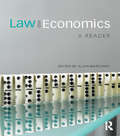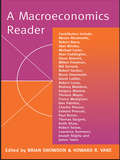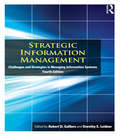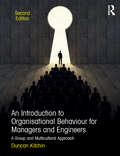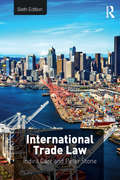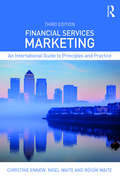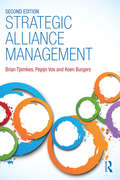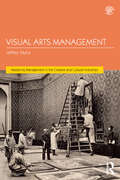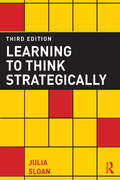- Table View
- List View
How Could This Happen?: Managing Errors in Organizations
by Jan U. HagenThe first comprehensive reference work on error management, blending the latest thinking with state of the art industry practice on how organizations can learn from mistakes. Even today the reality of error management in some organizations is simple: “Don’t make mistakes. And if you do, you’re on your own unless you can blame someone else.” In most, it has moved on but it is still often centered around quality control, with Six Sigma Black Belts seeking to eradicate errors with an unattainable goal of zero. But the best organizations have gone further. They understand that mistakes happen, be they systemic or human. They have realized that rather than being stigmatized, errors have to be openly discussed, analyzed, and used as a source for learning. In How Could This Happen? Jan Hagen collects insights from the leading academics in this field – covering the prerequisites for error reporting, such as psychological safety, organizational learning and innovation, safety management systems, and the influence of senior leadership behavior on the reporting climate. This research is complemented by contributions from practitioners who write about their professional experiences of error management. They provide not only ideas for implementation but also offer an inside view of highly demanding work environments, such as flight operations in the military and operating nuclear submarines. Every organization makes mistakes. Not every organization learns from them. It’s the job of leaders to create the culture and processes that enable that to happen. Hagen and his team show you how.
Political Economy in Macroeconomics (PDF)
by Allan DrazenOriginally, economics was called political economy, and those studying it readily accepted that economic decisions are made in a political world. But economics eventually separated itself from politics to pursue rigorous methods of analyzing individual behavior and markets. Recently, an increasing number of economists have turned their attention to the old question of how politics shape economic outcomes. To date, however, this growing literature has lacked a cogent organization and a unified approach. Here, in the first full-length examination of how political forces affect economic policy decisions, Allan Drazen provides a systematic treatment, organizing the increasingly influential "new political economy" as a more established field at the highly productive intersection of economics and political science. Although he provides an extraordinarily helpful guide to the recent explosion of papers on political economy in macroeconomics, Drazen moves far beyond survey, giving definition and structure to the field. He proposes that conflict or heterogeneity of interests should be the field's essential organizing principle, because political questions arise only when people disagree over which economic policies should be enacted or how economic costs and benefits should be distributed. Further, he illustrates how heterogeneity of interests is crucial in every part of political economy. Drazen's approach allows innovative treatment--using rigorous economic models--of public goods and finance, economic growth, the open economy, economic transition, political business cycles, and all of the traditional topics of macroeconomics. This major text will have an enormous impact on students and professionals in political science as well as economics, redefining how decision makers on several continents think about the full range of macroeconomic issues and informing the approaches of the next generation of economists.
The Politics of Economic Adjustment: International Constraints, Distributive Conflicts and the State (PDF)
by Stephan Haggard Robert R. KaufmanIn the 1980s some developing countries adopted orthodox market-oriented policies in response to international economic crises, others experimented with alternative programs, and still others failed to develop coherent adjustment strategies of any sort. Building on the case studies in Economic Crisis and Policy Choice, these essays offer comparative analysis of these divergent experiences with macroeconomic stabilization and structural adjustment. Barbara Stallings and Miles Kahler explore the external pressures on governments. Peter Evans and John Waterbury examine the role of the state in the adjustment process, Evans through the lens of earlier historical experience with economic restructuring, Waterbury by focusing on the politics of privatization. Joan Nelson analyzes the politics of income distribution in the adjustment process, and Haggard and Kaufman investigate the political correlates of inflation and stabilization. A final essay assesses the prospects for combining market-oriented reforms with political democratization.
Unlocking Financial Accounting
by Parminder Johal Beverly Vickerstaff Eileen McAuliffeUnlocking Business is a new kind of textbook for business students in their first and second year of a degree. Unlocking Financial Accounting provides the following benefits:- Strict coverage of key knowledge, concepts and ideas, keeping the title lean and focused and allowing students to find what they want without having to plough through thousands of pages.- Carefully written for the learner - case studies, exercises and seminar ideas are woven into the text to help students learn as quickly as possible and to retain that knowledge in the most time-efficient way.- Encourages good practice such as complete referencing and suggested wider reading, to help those who wish to obtain the best possible degree classification.- Useful web resources include further questions, revision summaries and interactive multiple-choice quizzes at http://www.hodderplus.co.uk/unlockingbusiness- A cost-effective way to prepare students for their studies.
Unlocking Human Resource Management
by Margaret Inman Nuala O'Sullivan Adrian MurtonUnlocking Business is a new kind of textbook for business students in their first and second year of a degree. Unlocking Human Resource Management provides the following benefits:- Strict coverage of key knowledge, concepts and ideas, keeping the title lean and focused and allowing students to find what they want without having to plough through thousands of pages.- Carefully written for the learner - case studies, exercises and seminar ideas are woven into the text to help students learn as quickly as possible and to retain that knowledge in the most time-efficient way.- Encourages good practice such as complete referencing and suggested wider reading, to help those who wish to obtain the best possible degree classification.- Useful web resources include further case studies, revision summaries and interactive multiple-choice quizzes at www.routledge.com/cw/inman - A cost-effective way to prepare students for their studies.
Business Economics (360 Degree Business)
by Rob DransfieldThe Eurozone crisis and the age of austerity, as well as challenges to the environment as a result of economic growth have highlighted the need for a greater understanding of those facets of economics that are of most use to businesses and their decision makers. This book introduces all of the relevant theoretical aspects of the subject and applies them to real-life examples of economics that are of particular interest to students today, including: the impact of globalization; the way in which ‘green’ perspectives can be built into decision making and how the financial crisis has challenged economists, politicians and business people to rethink their existing ideas. Replete with illuminating case studies, and benefitting from features such as activities, review questions and further reading, Business Economics introduces the theory and practice of economics for non-specialist students new to the topic.
Environmental Economics and Natural Resource Management
by David A. AndersonThe tools of environmental economics guide policymakers as they weigh development against nature, present against future, and certain benefits against uncertain consequences. From reluctant-but-necessary calculations of the value of life, to quandaries over profits at the environment’s expense, the policies and research findings explained in this textbook are relevant to decisions made daily by individuals, firms, and governments. The fourth edition of Environmental Economics and Natural Resource Management pairs the user-friendly approaches of the previous editions with the latest developments in the field. A story-based narrative delivers clear, concise coverage of contemporary policy initiatives. To promote environmental and economic literacy, we have added even more visual aids, including color photographs and diagrams unmatched in other texts. Ancillaries include an Instructor’s Guide with answers to all of the practice problems and downloadable slides of figures and tables from the book. The economy is a subset of the environment, from which resources are obtained, workers and consumers receive sustenance, and life begins. Energy prices and environmental calamities constrain economic growth and the quality of life. The same can be said about overly restrictive environmental policies. It is with an appreciation for the weighty influence of this discipline, and the importance of conveying it to students, that this textbook is crafted.
Environmental Economics and Natural Resource Management: And Natural Resource Management
by David A. AndersonThe tools of environmental economics guide policymakers as they weigh development against nature, present against future, and certain benefits against uncertain consequences. From reluctant-but-necessary calculations of the value of life, to quandaries over profits at the environment’s expense, the policies and research findings explained in this textbook are relevant to decisions made daily by individuals, firms, and governments. The fourth edition of Environmental Economics and Natural Resource Management pairs the user-friendly approaches of the previous editions with the latest developments in the field. A story-based narrative delivers clear, concise coverage of contemporary policy initiatives. To promote environmental and economic literacy, we have added even more visual aids, including color photographs and diagrams unmatched in other texts. Ancillaries include an Instructor’s Guide with answers to all of the practice problems and downloadable slides of figures and tables from the book. The economy is a subset of the environment, from which resources are obtained, workers and consumers receive sustenance, and life begins. Energy prices and environmental calamities constrain economic growth and the quality of life. The same can be said about overly restrictive environmental policies. It is with an appreciation for the weighty influence of this discipline, and the importance of conveying it to students, that this textbook is crafted.
Shipping Law
by Simon BaughenIn this well-established textbook, Simon Baughen expertly covers the whole spectrum of English shipping law, placing the highly specialised rules of shipping in a commercial context and relating them to the general principles of contract and tort law. The book’s accessible narrative and useful glossary of key terms will particularly benefit students new to Shipping Law or from non-law backgrounds. In-depth commentary on judicial decisions and well-balanced coverage and analysis of recent and key cases, such as The New Flamenco, The Ocean Victory, and The Kos, provide an up-to-date reference for all students on Shipping Law courses. The comprehensive overview of topics also ensures that the book is ably suited to course use, including discussion of such areas as: Bills of lading Charterparties Salvage Marine Pollution Arbitration Accidents and collisions Fully updated throughout, this sixth edition provides an invaluable source of reference and will be of use to both students and to those in practice.
Shipping Law
by Simon BaughenIn this well-established textbook, Simon Baughen expertly covers the whole spectrum of English shipping law, placing the highly specialised rules of shipping in a commercial context and relating them to the general principles of contract and tort law. The book’s accessible narrative and useful glossary of key terms will particularly benefit students new to Shipping Law or from non-law backgrounds. In-depth commentary on judicial decisions and well-balanced coverage and analysis of recent and key cases, such as The New Flamenco, The Ocean Victory, and The Kos, provide an up-to-date reference for all students on Shipping Law courses. The comprehensive overview of topics also ensures that the book is ably suited to course use, including discussion of such areas as: Bills of lading Charterparties Salvage Marine Pollution Arbitration Accidents and collisions Fully updated throughout, this sixth edition provides an invaluable source of reference and will be of use to both students and to those in practice.
Financial Accounting (360 Degree Business)
by Bev Vickerstaff Parminder JohalClear, concise, and written by experts currently lecturing in the field, Financial Accounting focuses exclusively on what you need to know for success in your course and career. Students looking for a focused introduction to financial accounting will appreciate this book. This innovative textbook includes features which will particularly appeal to international students, including: a clear introduction to accounting from its initial concepts, through recording transactions to the accurate interpretation of accounts relevant case studies that illustrate key accounting principles up-to-date terminology to prepare you for current business practice worldwide summaries, activities and review questions to help reinforce your understanding Part of the 360 Degree Business, which provides accessible yet stimulating introductions to core business studies modules, the text comes with additional support materials including interactive multiple choice questions available at www.routledge.com/cw/vickerstaff.
International Directory of Museum Training: Programs and practices of the museum profession (Heritage: Care-Preservation-Management)
by Gary EdsonChoosing the right museum training course may be one of the most important decisions a person makes in their career. Whether you are already working in a museum or are just beginning training you will need the most comprehensive and up-to-date information. The International Directory of Museum Training provides a list of museum training programmes worldwide with detailed information about each course. Every entry contains information about subjects offered, numbers of students, scholarship opportunities, and contact names and addresses. International Directory of Museum Training is co-published with ICTOP, the training committee of ICOM. It is the successor to the widely recognised Museum Studies International, last published in 1988. This completely new and fully updated volume enhances the qualities of the earlier publication and updates the presentation to make the volume easier to use. This is an essential reference book for all who are hoping to develop a career in museum work or to enhance their professional qualifications.
International Directory of Museum Training: Programs and practices of the museum profession (Heritage: Care-Preservation-Management)
by Gary EdsonChoosing the right museum training course may be one of the most important decisions a person makes in their career. Whether you are already working in a museum or are just beginning training you will need the most comprehensive and up-to-date information. The International Directory of Museum Training provides a list of museum training programmes worldwide with detailed information about each course. Every entry contains information about subjects offered, numbers of students, scholarship opportunities, and contact names and addresses. International Directory of Museum Training is co-published with ICTOP, the training committee of ICOM. It is the successor to the widely recognised Museum Studies International, last published in 1988. This completely new and fully updated volume enhances the qualities of the earlier publication and updates the presentation to make the volume easier to use. This is an essential reference book for all who are hoping to develop a career in museum work or to enhance their professional qualifications.
Law and Economics: A Reader
by Alain MarcianoThis book brings together the most authoritative articles on Law and Economics and the interaction between the two disciplines as well as the use of economic tools to analyse legal problems. Aimed at students experiencing the subject for the first time, the selections are interlaced with a wealth of features including explanatory introductions and exercises. Key features of the reader include: - The accessibility of the material: the articles should be understandable to those with only a limited background in economics and law. - The book’s focus on the most important and basic – foundational – issues in law and economics. - An exposition of the opposition between the different legal systems that exist in the world including common law, civil law and public law. - Debates viewed from the perspective of the scholars from a range of backgrounds are presented as well as all the key figures in economics and in law. The book should prove to be an essential resource to all students studying this burgeoning field and represents an exciting introduction to one of the key disciplines which has grown up in the social sciences in recent times.
Law and Economics: A Reader (New Horizons In Law And Economics Ser. #18)
by Alain MarcianoThis book brings together the most authoritative articles on Law and Economics and the interaction between the two disciplines as well as the use of economic tools to analyse legal problems. Aimed at students experiencing the subject for the first time, the selections are interlaced with a wealth of features including explanatory introductions and exercises. Key features of the reader include: - The accessibility of the material: the articles should be understandable to those with only a limited background in economics and law. - The book’s focus on the most important and basic – foundational – issues in law and economics. - An exposition of the opposition between the different legal systems that exist in the world including common law, civil law and public law. - Debates viewed from the perspective of the scholars from a range of backgrounds are presented as well as all the key figures in economics and in law. The book should prove to be an essential resource to all students studying this burgeoning field and represents an exciting introduction to one of the key disciplines which has grown up in the social sciences in recent times.
A Macroeconomics Reader
by Howard Vane Brian SnowdonA Macroeconomics Reader brings together a collection of key readings in modern macroeconomics. Each article has been carefully chosen to provide the reader with accessible, non-technical, and reflective papers which critically assess important areas and current controversies within modern macroeconomics.The book is divided into six parts, each with a separate introduction highlighting the relevance of the ensuing articles. The areas covered include: Keynes's General Theory, Keynesian economics and the Keynesian revolution; monetarism; rational expectations and new classical macroeconomics; real business cycle approaches: New Keynesian economics: economic growth.This book will be an essential guide for students and lecturers in the field of macroeconomics as well as those interested in the history of economic thought.
Strategic Information Management: Challenges and Strategies in Managing Information Systems
by Robert D. Galliers Dorothy E. LeidnerToday there are few organizations that can afford to ignore information technology and few individuals who would prefer to be without it. As managerial tasks become more complex, so the nature of the required information systems changes from structured, routine support to ad hoc, unstructured, complex enquiries at the highest levels of management. As with the first three editions, this fourth edition of Strategic Information Management: Challenges and Strategies in Managing Information Systems presents the many complex and inter-related issues associated with the management of information systems. This book provides a rich source of material reflecting recent thinking on the key issues facing executives in information systems strategic management. It draws from a wide range of contemporary articles written by leading experts from North America, Asia, and Europe. Designed as a course text for MBA, Master's level students, and senior undergraduate students taking courses in information management, it also provides a wealth of information and references for researchers. New to this edition are updated readings addressing current issues and the latest thinking in information management.
Strategic Information Management: Challenges and Strategies in Managing Information Systems (Management Reader Ser.)
by Robert D. Galliers Dorothy E. LeidnerToday there are few organizations that can afford to ignore information technology and few individuals who would prefer to be without it. As managerial tasks become more complex, so the nature of the required information systems changes from structured, routine support to ad hoc, unstructured, complex enquiries at the highest levels of management. As with the first three editions, this fourth edition of Strategic Information Management: Challenges and Strategies in Managing Information Systems presents the many complex and inter-related issues associated with the management of information systems. This book provides a rich source of material reflecting recent thinking on the key issues facing executives in information systems strategic management. It draws from a wide range of contemporary articles written by leading experts from North America, Asia, and Europe. Designed as a course text for MBA, Master's level students, and senior undergraduate students taking courses in information management, it also provides a wealth of information and references for researchers. New to this edition are updated readings addressing current issues and the latest thinking in information management.
An Introduction to Organisational Behaviour for Managers and Engineers: A Group and Multicultural Approach
by Duncan KitchinAn Introduction to Organisational Behaviour for Managers and Engineers: A Group and Multicultural Approach gives a comprehensive overview of how organisations work, with a special focus on group and team working, and issues of diversity and intercultural management. This second edition has been updated throughout, drawing on the latest literature, along with: a new chapter on organisational change, a process which all managers and engineers will encounter on the job; case studies and illustrations showing theories in action; more cross-referencing between chapters, showing how topics are interlinked. This concise textbook not only provides a practical introduction to organisational behaviour for management students, but is also specifically geared towards the needs of engineering students and professionals.
International Trade Law
by Indira Carr Peter StoneInternational Trade Law offers a clear overview of the complexities of an international sale transaction through informed analysis of case law, legislation, and international conventions and rules. Fully updated with changes to the law and new directions in legal debate, this new edition considers: Standard trade terms including INCOTERMS 2010, the Convention on International Sales of Goods 1980 and the UNIDROIT Principles for International Commercial Contracts E-Commerce issues, including electronic bills of lading Insurance and payment mechanisms, such as letters of credit and the UCP 600 International transportation of cargo, including the Rotterdam Rules Dispute resolution (including jurisdiction, applicable law, arbitration and mediation), with particular reference to the relevant EU regulations and the developing case-law thereon Corruption and anti-corruption conventions, including the UK Bribery Act 2010 and developments relating to deferred prosecution agreements In addition to clarifying a range of topics through tables and diagrams, the book directs readers to relevant further reading and online resources throughout, offering students an accessible resource to this often challenging area of the law.
Financial Services Marketing: An International Guide to Principles and Practice
by Christine Ennew Nigel Waite Roisin WaiteNow in its 3rd edition, Financial Services Marketing offers a balanced and useful guide to the topic that is both conceptual and practical. The authors have drawn from extensive international experience to ensure that this text will resonate with users across the globe. This edition is complemented by numerous international references, examples and case studies featuring companies such as American Express, Direct Line, Barclays, NatWest RBS, Aviva and HSBC. This fully updated and revised edition features: An expanded section on regulation which has international reach and addresses the post-Brexit world Greatly expanded coverage of digital marketing at both the strategic and tactical levels New material on how to improve a company’s trustworthiness and safeguard a culture that is customer-focussed New examples, vignettes and case studies that showcase best practice from around the world B2B and B2C marketing Upgraded PowerPoint support on the companion website Financial Services Marketing 3e will be hugely beneficial to academic students of marketing and finance, as well as essential reading to those industry-based and studying for professional qualifications.
Strategic Alliance Management
by Brian Tjemkes Pepijn Vos Koen BurgersStrategic alliances – partnerships between separate organizations to share resources collaboratively toward mutually beneficial goals – are an important management instrument, but one that is difficult for firms to manage. Among many desirable outcomes, alliances can reduce costs, provide access to new technology, and improve research and development endeavours, though collaborative arrangements come with risks, peril, and adversities. This renewed and re-worked text connects theory to practice to help understand this important business practice. Strategic Alliance Management presents an academically grounded alliance development framework, detailing eight stages of alliance development with consideration for specific management challenges. For each stage, readers are presented with state-of-the-art theoretical insights, evidence-based managerial guidelines and a business case illustration. Additional chapters detail on contemporary alliance management challenges, including co-opetition and business eco-systems. Other chapters highlight the role of alliance professionals, alliance capabilities and paradoxical challenges in alliance relationships. This second edition retains a blend of academic knowledge and practical examples, while updating case examples and adding five new chapters on emerging alliance topics. This book remains vital reading for business students and professionals interested in strategic management.
Visual Arts Management (Discovering the Creative Industries)
by Jeffrey TaylorThe arts sector is of vital importance to the global economy and students aspiring to a career in the visual arts are increasingly required to gain an understanding of the business side of the arts world. This textbook introduces the field of arts management with a focus on visual arts. Visual Arts Management provides the first comprehensive textbook to the art business. The book covers the full range of the art world from contemporary galleries, secondary market, auction houses, art fairs, and museums. Topics include overviews of the distinct sectors of the business, but also delves in to technical topics: curatorship, antiques, cultural heritage compliance, marketing, art criticism, taxation, customs, insurance, transportation, appraising, conservation, and connoisseurship. Each chapter concludes with a real-world case study to provide cautionary tales of the dangers and pitfalls of the art business. This unique textbook, authored by an experienced instructor, presents a global perspective on the rapidly developing art business in a way that is relevant for arts management classes and art professionals worldwide.
Learning to Think Strategically
by Julia SloanStrategic thinking has become a core competency for business leaders globally. Overused and under-defined, the term is often used interchangeably with other strategic management terms. This textbook delineates and defines strategic thinking as a conceptual cognitive capability, focusing on the nonlinear, divergent, and informal nature of strategic thinking. In this third edition of a popular text, the author provides an unconventional definition and model for strategic thinking based on critical theory. This research-based book introduces the concept as the foundation of business strategy that is distinct from strategic planning and strategic implementation. New features, including executive summaries and key critical reflective questions, along with new and updated figures, make the book vital reading for MBA, leadership development, and executive education students. The practical nature of this book also makes it valuable for business and policy executives, managers, and emerging leaders.
Museum Exhibition: Theory and Practice (Heritage: Care-Preservation-Management)
by David DeanMuseum Exhibition is the only textbook of its kind to consider exhibition development using both theory and practice in an integrated approach. This comprehensive study covers care of exhibits, writing accompanying text, using new technology, exhibition evaluation, administration and content for a wide range of collections. It provides a complete outline for all those concerned with providing displays in musuems and other cultural heritage contexts.
